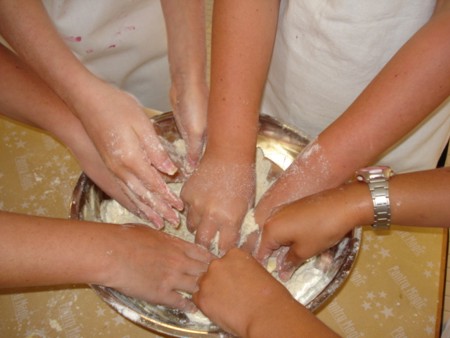Automatic dish washers usually eliminate 99.9 per cent of the gunk and germs in every load. But when you hand wash kitchen ware, there’s a much greater chance you’ll miss something. It’s as easy, for example, as not washing properly under the rims of your mixing bowls and storage containers – where dirty fingers are constantly landing.
Hand tools
If, like most folks, you have hand tools such as knives, ladles, mixing spoons or spatulas that have handles made from plastic, wood or rubber, which should not go into the dish washer, you should always be sue to get right into the joint between the handle material and the business end of the tool. That crack will trap food debris which makes an ideal breeding ground for germs. And those germs could be transferred to the next dish you prepare with improperly cleaned hand tools.
How often do you clean the business end of your can opener? Never? Thought so. That’s a great place for gunk to collect long-term and breed germs. I’ve seen it over and over again: People fastidiously clean the tops of food cans before opening them and then use a grungy old can opener to open them! If you have an old-school all-metal can opener, it can be tossed in the dish washer. If yours is festooned with plastic handles and other stuff, use a small scrub brush (like a vegetable brush) to get into all the nooks and crannies around the blade and the clamp mechanism.
Same goes for the hinge of your kitchen scissors, especially if they’ve been used on raw Chicken or other protein. Gunk will build up there in any event, so use the brush to get them really clean, too.
Small appliances
There are myriad places for food debris to hide in and around your small kitchen appliances. Let’s look at just a few of the germ-friendly hidey-holes in a typical food processor.
Any recess such as the “chimney” on the processor lid, or the hollow interior of the pusher, or the drive channel in the centre shaft of the chopper blade begs special attention. And make sure you give special attention to the threads on the lid and the bowl of the processor, where food spatter may land.
Many of the points we made about the food processor can also apply to your upright (or “bar”) blender. In fact, anything with rotating blades – especially stick blenders – should be accorded special attention at points where metal meets rubber or rubber meets glass/plastic. Gunk can easily adhere to or get under the edges of rubber gaskets.
The spice/coffee grinder is another special case. You don’t want to immerse it in water, for sure! Use a lightly dampened cloth or towel to wipe it out. make sure you get into all the little joints and crevices and under the blade. Also, do yourself a favour and never, ever use your spice grinder for fresh (moist) herbs. Not only will the herbs go totally mushy, you’ll have a horrible job ahead of you cleaning the grinder.
Containers
We already talked, briefly, about mixing bowls and storage containers. Let me now add to my admonition to clean under the rims. If you use snap-lid storage containers, be sure to clean the tongue on the container itself as well as the groove in the lid into which the tongue snaps.
And here’s an important tip: Clean the outside and bottom of every prep container and storage container as thoroughly as you clean the interior. It just makes sense. After all, as you’re working with the food, you’re touching the outside of the container all along the line…
When you use storage containers with threaded lids, always make sure that the threads on both the lid and the container are thoroughly cleaned.
Take it from here…
Now… We’ve covered all the main potential pitfalls and hidden horrors of hand washing your kitchen ware, it’s your time to shine. just like your dishes! Go ahead and apply the principles we’ve discussed to Garlic presses, vegetable peelers, Cherry pitters and all the other special tools you rely on in your kitchen.
And take pride in your high standard of kitchen cleanliness and food safety!
~ Maggie J.

